When a child has learned to write their name this can seem like a huge milestone. It is also very useful practically, particularly in school or nursery, so they can sign their own work and not get it mixed up with someone else’s by mistake.
But the process of name writing can be quite a complex one, and there are a few pitfalls that it is worth avoiding. This is where this article will come to your aid!
To give the short answer first, how do you teach children to write their name?
It is important to judge when children are actually able developmentally to write their name. When you think they have reached this point, introduce name writing with fun games and activities. Make up fun stories about the letters in their name, and help them copy them.
Now let’s get stuck into the full version, because there is definitely more to it than that!
This article can just as easily be used by parents as teachers, and the same guidelines will apply.
There are many questions people have – what should they start name writing? How do you introduce it? Can you start to early? How can you help them improve their name writing efforts?
I will answer all of these questions, and also quite a few more.
I have taught children from the age of 3 to 5 for the last ten years, and I have seen many of the pitfalls as well as many of the secrets of how to teach name writing. So here we go…
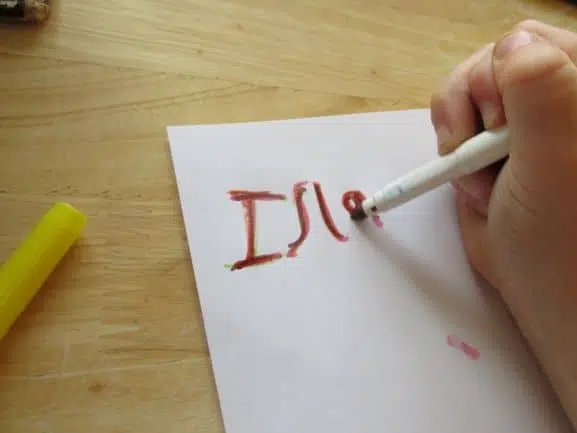
Wait For The Right Time To Teach Name Writing
Getting the timing right is absolutely critical!
The main danger is starting too early. If this happens then there could be many problems, including:
- Their hand hurts when they are forced to write because the muscles have not developed to a degree where they can do it. This can put them off writing for a long time, or even permanently
- The process can become a really long and drawn out one lasting a huge amount of time. This is time wasted, as they could be doing other much more valuable things
- They can tell they can’t do it, and this impacts their self-esteem. This can put them off writing. Developing fine motor skills in a positive way has numerous benefits.
These are all serious issues, and definitely not worth it for just writing a name.
On the other end of the spectrum is starting too late an issue?
I would say starting too late is not really a problem at all. It just means your child will be able to learn the skill in record time!
Anyway, here are just a few things to think about in terms of timing:
It Is Not A Competition!
Often parents will be become very competitive about the milestones their children reach compared with the children of their friends of work colleagues.
This is very natural, but often not a positive influence, particularly in the early years where development does not really happen in a gradual way.
Often children will make rapid progress all of a sudden in an area when they become ready, but this will not happen if they have put off first.
It really is like the tortoise and the hare! Just because one child of 3 can write their name, and your child of 4 can’t, this does not mean the child of 3 is far cleverer, and will grow up to be much more intelligent than your child. It really does not mean that!
The rate of progress children make is not linear. Some will progress more slowly than others for a period, and then suddenly far more rapidly than others for the next period.
Anyway, try not to think in terms of competition. You want to think about when the child is ready – that’s it!
Girls V Boys
This is definitely another area that it is worth knowing about.
Put simply, in general girls develop their fine motor skills earlier than boys. This is just a quirk of nature. This will often mean that girls will be able to write their names earlier and skilfully than boys.
Of course this is not always the case, but as an average this is what will happen across the population.
What To Look For To Know They’re Ready
Right, this is the important bit in terms of timing – the signs to look for to know that they are probably ready to take on name writing.
These include:
- They are beginning to mark-make, and will make marks for a least some short period of time. This could be with encouragement from an adult or independently. Got reluctant children? Then try this
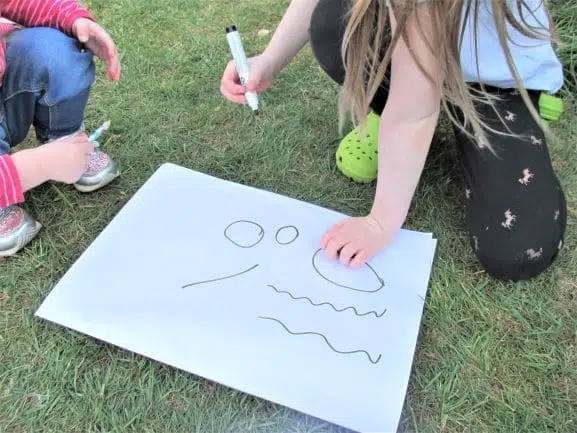
- They are able to form at least circles and straight lines in their emergent writing
- Their pictures are starting to look a bit like what they are supposed to be. This could be things like an image of a person that you can make out
- They know what their name is, and understand the concept of having a name
- They can recognize their name (a bit more about this in a moment)
- Knowing the names of at least some letters and sounds is optional but does help
When these things are happening, then you are definitely ready to go.
Name Recognition
This is a crucial step to go through before you start the actual process of name writing.
It is good for children to be acquainted with their name before they start to write it.
Some good ways to get them going with this include:
- Clothes – Have it in the neck of their coat for example
- Books – Sometimes there will be character in books that share the same name as the child! Show them the name written down
- Bag – Have it written on any bags they own
- Put it on paintings or drawings – it is good for them to see you write their name, and you can talk about what it is
- Have it displayed in house or around setting. At school their name could feature in displays, or with a picture of them with their name on the wall
- Name Peg – This is probably not one for parents, but rather in preschools and schools
How To Introduce Name Writing
Right, when they are ready to go, here is a good way to introduce it.
It is probably best through play-based learning, so name writing is not the main emphasis of the activity.
For example, if they have just drawn a picture, this could be a good time to get them to try to write their name.
The simplest way is probably to write one letter at a time for them, and get them to copy the letter underneath. Then write the next letter, get them to copy that, and so on.
I normally write a little dot where they can start writing their letter from.
This simple process can be practised with different things thrown in to help the process, and bring it to life!
Whenever you help them write their name in play-based situations, try some of these to get the process going:
1.Have A Little Story For Letters
This is easier to do for some letters than other. But, for example, for an ‘b’ you could say something like ‘We’re going down lane and round the pond.’
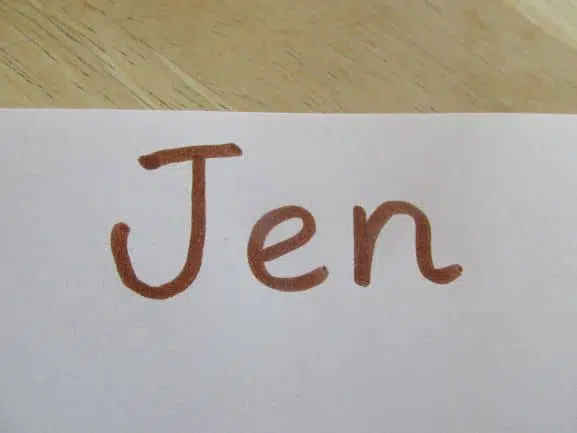
Making it into a little story like that really helps.
If children can think of their own little stories for letters in their name, then brilliant! Ownership is a powerful motivator, and the more children can take charge of their own learning the better.
2.Talk About Shape Of Letters
Some letters are quite easy. For example, an ‘o’ is just ‘a circle,’ or ‘i’ is a stick with a dot on.
Talking about the shapes of letters as you model how to write them, helps children get to grips with the process.
3. Say Letter Sounds
If the children know any of the letters or sounds in their name, then this often helps the process.
Talk about the sounds, and any they recognize. This often captures their attention.
If they can sound them out then even better.
9 Fun Games To Teach Children To Name Write
To Turn the process of then practising name writing into something fun and interesting, it is good to try out different games.
Here are some of the best:
1.Write Over The Dots
This is one of the classic ways to practise name writing!
It’s really simple – just write their name in dots and they draw over the top.
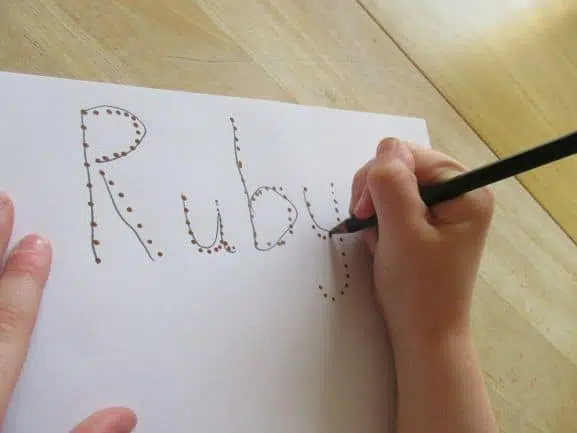
Other ways to do it include:
2. Yellow Highlighter Pen
This is a similar idea. Write their name in yellow highlighter and they write over the top of it in pencil or pens.
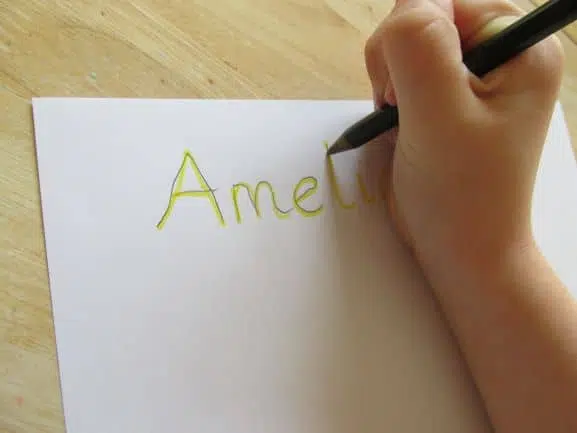
3. Laminate Their Dot Name
If you try it this way, then you only have to make their dot name once. This can save a lot of time.
Simply create the child’s name using dots written on a small card. Then laminate the card. They can write over their name multiple times with pens, and simply wipe it off when finished ready for next time.
4.Write In Messy Play Substances
Mark-making with fingers is one of the best ways of tapping into children’s excitement and enthusiasm for mark-making.
You can mark-make with fingers in many different substances including foam, shaving gel, sand, glitter, or porridge oats. They can try writing their names, perhaps helped by a name card if required.
5.Paint
Many children that are not that keen on writing with pencils and pens, but they do enjoy painting. Tap into this enthusiasm by having a go of painting their names with all sorts of rainbow colors.
6.Use Interesting Mark-Making Tools
It is surprising how much more interested children are in mark-making, if they have something exciting to write with. For example, a stick with crayon stuck to the top.
Or an invisible ink pen!
Or a torch with a pen stuck to it, to turn it into a top-secret dark den pen!
Any ideas like this are good for more reluctant children, to hopefully get them involved in name writing in a fun way.
7.Drive It With Vehicles
Tapping into interests is another way of getting more reluctant children to be interested.
Vehicles are a classic one for this. Simply stick pens to vehicles with tape. They can drive the pens around, trying to write their names.
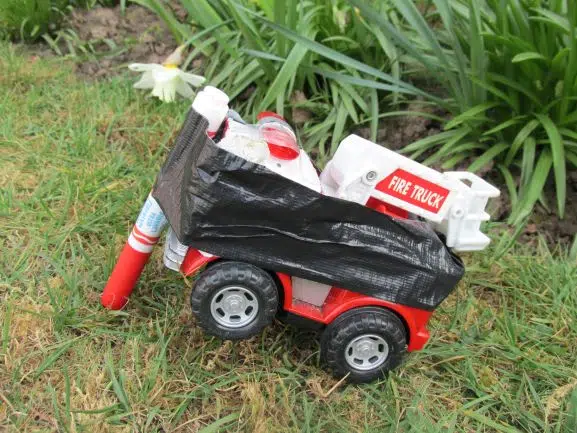
You could write their names on huge paper for them to drive around.
8.Draw It With Magic Wands
Big sky-writing in the air really helps children’s gross motor, as well as their fine motor skills. To find out more about the 12 main differences between fine and gross motor skills, check this article out.
Using things like wands in the air really brings this process to life! Or you could use ribbons or streamers, or something else like that. Have their name written big somewhere and encourage them to form the letters in the air.
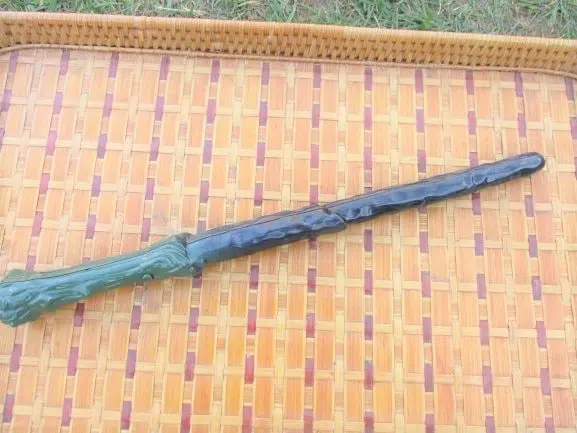
9. Copy A Name Card!
This is probably not quite as fun as the others in this list, but it just works! It probably works the best out of all of them.
Give a child a name card, and get them to copy it. It’s as simple as that.
It’s good to keep the name cards somewhere where they can access them independently. Then the children can find their name whenever they need to write it on a piece of work.
Strategies For Continuing To Improve
We can all improve in pretty much anything we do!
And as children learn to write better, and also acquire more phonics skills, it is good to keep improving their name writing.
If you don’t do this, then some children will kind of get stuck writing their name in the way they have always done it. They develop a kind of ‘monikor’, a bit like a signature.
Even when some children are able to write most of the letters recognizably and with good letter formation, their name will then be lagging behind this and show many strange quirks, ‘fake letters’, and other things like that!
The key is to keep on teaching name writing just now and then.
Some things to work on include:
1.Tall And Small Letters
This will not be a concern when you start the process, but later on they will learn about tall and short letters.
This is not rocket science – some letters are tall, such as ‘l, b, t, h’, and some are small – ‘a, e, i, o’ for example. Practise making the small letter much smaller than the tall, and vice versa.
2. Letter Formation
Children will begin to learn skills like putting flicks in the right places in letters. Apply this to name writing!
As they work through phonics, they will learn how form the letters correctly, and it is good to practice this in their names. Often this will mean undoing what they are currently doing, which is not as easy as it seems.
3. General Size Of Writing
Generally children will begin writing smaller as their fine motor and pencil grip develops, and they start writing on lines.
Support this, and help them try to write their names smaller at the same time.
4. Adding Other Names
The next step with your name is to attempt writing any other names you have as well, such as middle names or last names.
Some Of The Things That Can Go Wrong (And How To Sort It)
1.They Forget To Do It
This is not so much of a problem with the name writing process. It is just the forget to actually write their name on pieces of work they do.
Encourage to write their name, and give huge amounts of praise when they attempt to do so!
2.They Get Possessive Of Letters In Their Name
This is a weird issue that you might encounter!
Some children find out they have a letter in their name, e.g. ‘a’, but then get a bit territorial about it!
If they see another children writing their name, and they also have an ‘a’, they can get quiet defensive, or tell the other child that the letter is there’s and shouldn’t be used by others.
This is especially true with capital letters.
The best way to get past this is just a bit of common sense. Explain that there are lots of the same letters in many children’s names. You might have to repeat the message a few times, but in the end it should be understood.
3.Children Are Resistant
Often children don’t want to write their name, or say they can’t (even though you think they can).
Once again, use positive strategies as much as possible, such as:
- Massive levels of encouragement to give it a go
- Huge amounts of praise if they try
- Potentially some kind of reward if they write their name
- Praise their peers as much and publicly as you can
Conclusion
Name writing really is a matter of timing for the individual child. If you start at the right time, then you just need to make the process fun, and later help them improve what they are doing.
Name writing is of course just one very small piece of the jigsaw of fine motor development and early writing.
Check out these:
